How Flood Hazard Maps Improve the Understanding of Ecologically Active Floodplains
Abstract
:1. Introduction
2. Materials and Methods
2.1. Setting
2.2. Data and Data Processing
3. Results
3.1. Comparison of Extent, Water Depth and Static Water Volume between T-Frequent and T-Medium Floodplains
3.2. Indicating Naturalness: Land Use, Protected Habitats and Vegetation Cover
3.3. Actual and Statistical Inundation in T-Frequent Floodplains
4. Discussion
4.1. Delineating Floodplain Borders Considering Their Importance for Regulation Functions
4.2. Indicator for Naturalness of Floodplains and Ecosystem Functioning
4.3. Reliability of Results: Limits of FHM Data
5. Conclusions
Supplementary Materials
Author Contributions
Funding
Institutional Review Board Statement
Informed Consent Statement
Data Availability Statement
Acknowledgments
Conflicts of Interest
References
- Costanza, R.; D’Arge, R.; de Groot, R.; Farber, S.; Grasso, M.; Hannon, B.; Limburg, K.; Naeem, S.; O’Neill, R.; Paruelo, J.; et al. The value of the world’s ecosystem services and natural capital. Nature 1997, 387, 253–260. [Google Scholar] [CrossRef]
- Junk, W.; Bayley, P.B.; Sparks, R.E. The flood pulse concept in river-floodplain systems. Can. Spec. Publ. Fish. Aquat. Sci. 1989, 106, 110–127. [Google Scholar]
- Naiman, R.J.; Décamps, H. The ecology of interfaces: Riparian zones. Annu. Rev. Ecol. Syst. 1997, 28, 621–658. [Google Scholar] [CrossRef] [Green Version]
- Ward, J.V. Riverine landscapes: Biodiversity patterns, disturbance regimes, and aquatic conservation. Biol. Conserv. 1998, 83, 269–278. [Google Scholar] [CrossRef]
- Poff, N.L.; Allan, J.D.; Bain, M.B.; Karr, J.R. The natural flow regime: A new paradigm for riverine conservation and restoration. BioScience 1997, 47. [Google Scholar] [CrossRef]
- Fernandes, M.R.; Aguiar, F.C.; Ferreira, M.T. Assessing riparian vegetation structure and the influence of land use using landscape metrics and geostatistical tools. Landsc. Urban Plan. 2011, 99, 166–177. [Google Scholar] [CrossRef] [Green Version]
- Leyer, I. Effects of dykes on plant species composition in a large lowland river floodplain. River Res. Appl. 2004, 20, 813–827. [Google Scholar] [CrossRef]
- Jackson, M.B.; Colmer, T.D. Response and adaptation by plants to flooding stress. Ann. Bot. 2005, 96, 501–505. [Google Scholar] [CrossRef]
- Weissteiner, C.J.; Ickerott, M.; Ott, H.; Probeck, M.; Ramminger, G.; Clerici, N.; Dufourmont, H.; De Sousa, A.M.R. Europe’s green arteries—A continental dataset of riparian zones. Remote Sens. 2016, 8, 925. [Google Scholar] [CrossRef] [Green Version]
- Brunotte, E.; Dister, E.; Gunther-Diringer, D.; Koenzen, U.; Mehl, D. Flussauen in Deutschland–Erfassung und Bewertung des Auenzustandes. In Naturschutz und Biologische; Bad Godesberg: Bonn, Germany, 2009. [Google Scholar]
- Schulz-Zunkel, C.; Krueger, F. Trace metal dynamics in floodplain soils of the river elbe: A review. J. Environ. Qual. 2009, 38, 1349–1362. [Google Scholar] [CrossRef]
- Weaver, J.C.; Feaster, T.D.; Gotvald, A.J. Magnitude and Frequency of Rural Floods in the Southeastern United States, through 2006—Volume 2, North Carolina. 2009, U.S. Geological Survey Scientific Investigations Report 2009–5158; BiBlioGov: Reston, VA, USA, 2011; p. 111. [Google Scholar]
- Chapin, D.M.; Beschta, R.L.; Shen, H.W. Relationships between flood frequencies and riparian plant communities in the Upper Klamath Basin, Oregon. J. Am. Water Resour. Assoc. 2002, 38, 603–617. [Google Scholar] [CrossRef]
- Hughes, F.M.R.; Rood, S.B. Allocation of river flows for restoration of floodplain forest ecosystems: A review of approaches and their applicability in Europe. Environ. Manag. 2003, 32, 12–33. [Google Scholar] [CrossRef] [PubMed]
- BMU; BfN. Auenzustandsbericht. Flussauen in Deutschland; Bundesamt fur Naturschutz: Bonn, Germany, 2009. [Google Scholar]
- Erős, T.; Bányai, Z. Sparing and sharing land for maintaining the multifunctionality of large floodplain rivers. Sci. Total Environ. 2020, 728, 138441. [Google Scholar] [CrossRef] [PubMed]
- Entwistle, N.S.; Heritage, G.L.; Schofield, L.A.; Williamson, R.J. Recent changes to floodplain character and functionality in England. CATENA 2019, 174, 490–498. [Google Scholar] [CrossRef]
- Grizzetti, B.; Liquete, C.; Pistocchi, A.; Vigiak, O.; Zulian, G.; Bouraoui, F.; De Roo, A.; Cardoso, A.C. Relationship between ecological condition and ecosystem services in European rivers, lakes and coastal waters. Sci. Total Environ. 2019, 671, 452–465. [Google Scholar] [CrossRef]
- Scholz, M.; Mehl, D.; Steinhauser, A.; Kasperidus, H.D. Ökosystemfunktionen von Flussauen–Analyse und Bewertung von Hochwasserretention, Nährstoffrückhalt, Kohlenstoff, Treibhausgasemissionen und Habitatfunktion. In Naturschutz und Biologische; Bad Godesberg: Bonn, Germany, 2012. [Google Scholar]
- EC. Directive 2007/60/EC of the European Parliament and of the Council of 23 October 2007 on the assessment and management of flood risks. Off. J. Eur. Union 2007, 288, 1–8. [Google Scholar]
- Wolman, G.M.; Miller, J.P. Magnitude and frequency of forces in geomorphic processes. J. Geol. 1960, 68, 54–74. [Google Scholar] [CrossRef] [Green Version]
- Schulte in den Bäumen, H.; Többen, J.; Lenzen, M. Labour forced impacts and production losses due to the 2013 flood in Germany. J. Hydrol. 2015, 527, 142–150. [Google Scholar] [CrossRef]
- Venohr, M.; Hirt, U.; Hofmann, J.; Opitz, D.; Gericke, A.; Wetzig, A.; Natho, S.; Neumann, F.; Hurdler, J.; Matranga, M.; et al. Modelling of nutrient emissions in river systems–Moneris–Methods and background. Int. Rev. Hydrobiol. 2011, 96, 435–483. [Google Scholar] [CrossRef]
- Clerici, N.; Paracchini, M.L.; Maes, J. Land-cover change dynamics and insights into ecosystem services in European stream riparian zones. Ecohydrol. Hydrobiol. 2014, 14, 107–120. [Google Scholar] [CrossRef]
- Clerici, N.; Weissteiner, C.J.; Paacchini, M.L.; Boschetti, L.; Baraldi, A.; Strobl, P. Pan-European distribution modelling of stream riparian zones based on multi-source Earth Observation data. Ecol. Indic. 2013, 24, 211–223. [Google Scholar] [CrossRef]
- UNEP-WCMC; IUCN. Protected Planet: [The World Database on Protected Areas (WDPA)]. Available online: www.protectedplanet.net (accessed on 17 December 2019).
- UNEP-WCMC. World Database on Protected Areas User Manual 1.5. UNEP-WCMC. 2017. Available online: http://wcmc.io/WDPA_Manual (accessed on 17 December 2019).
- Schindler, S.; O’Neill, F.H.; Biro, M.; Damm, C.; Gasso, V.; Kanka, R.; van der Sluis, T.; Krug, A.; Lauwaars, S.G.; Sebesvari, Z.; et al. Multifunctional floodplain management and biodiversity effects: A knowledge synthesis for six European countries. Biodivers. Conserv. 2016, 25, 1349–1382. [Google Scholar] [CrossRef]
- BfN. Potential Natural Vegetation of Germany; Bundesamt fur Naturschutz: Bonn, Germany, 2011. [Google Scholar]
- Polley, H.; Heinrich, J. Aufnahmeanweisung für die dritte Bundeswaldinventur (BWI) (2011–2012), 2nd ed.; Johann Heinrich von Thünen Institute: Braunschweig, Germany, 2011. [Google Scholar]
- Natho, S.; Thieken, A.H. Implementation and adaptation of a macro-scale method to assess and monitor direct economic losses caused by natural hazards. Int. J. Disaster Risk Reduct. 2018, 28, 191–205. [Google Scholar] [CrossRef]
- Stammel, B.; Amtmann, M.; Gelhaus, M.; Cyffka, B. Change of regulating ecosystem services in the Danube floodplain over the past 150 years induced by land use change and human infrastructure. Erde 2018, 149, 145–156. [Google Scholar] [CrossRef]
- Natho, S.; Venohr, M.; Henle, K.; Schulz-Zunkel, C. Modelling nitrogen retention in floodplains with different degrees of degradation for three large rivers in Germany. J. Environ. Manag. 2013, 122, 47–55. [Google Scholar] [CrossRef]
- EEA. Flood Risks and Environmental Vulnerability: Exploring the Synergies Between Floodplain Restoration, Water Policies and Thematic Policies; European Environmental Agency: Copenhagen, Denmark, 2016. [Google Scholar]
- Kienast, F.; Bolliger, J.; POtschin, M.; de Groot, R.S.; Verburg, P.H.; Heller, I.; Wascher, D.; Haines-Young, R. Assessing Landscape Functions with Broad-Scale Environmental Data: Insights Gained from a Prototype Development for Europe. Environ. Manag. 2009, 44, 1099–1120. [Google Scholar] [CrossRef] [Green Version]
- Gordon, B.A.; Dorothy, O.; Lenhart, C.F. Nutrient retention in ecologically functional floodplains: A review. Water 2020, 12, 2762. [Google Scholar] [CrossRef]
- Hupp, C.R.; Kroes, D.E.; Noe, G.B.; Schenk, E.R.; Day, R.H. Sediment trapping and carbon sequestration in floodplains of the lower Atchafalaya Basin, LA: Allochthonous versus autochthonous carbon sources. J. Geophys. Res. Bio-Geosci. 2019, 124, 663–677. [Google Scholar] [CrossRef]
- Yarnell, S.M.; Petts, G.E.; Schmidt, J.C.; Whipple, A.A.; Beller, E.E.; Dahm, C.N.; Goodwin, P.; Viers, J.H. Functional flows in modified riverscapes: Hydrographs, habitats and opportunities. BioScience 2015, 65, 963–972. [Google Scholar] [CrossRef] [Green Version]
- Arrighi, C.; Masi, M.; Iannelli, R. Flood risk assessment of environmental pollution hotspots. Environ. Model. Softw. 2018, 100, 1–10. [Google Scholar] [CrossRef]
- Lyubimova, T.; Lepikhin, A.; Parshakova, Y.; Tiunov, A. The risk of river pollution due to washout from contaminated floodplain water bodies during periods of high magnitude floods. J. Hydrol. 2016, 534, 579–589. [Google Scholar] [CrossRef]
- Ponting, J.; Kelly, T.J.; Verhoef, A.; Watts, M.J.; Sizmur, T. The impact of increased flooding occurrence on the mobility of potentially toxic elements in floodplain soil—A review. Sci. Total Environ. 2021, 754, 142040. [Google Scholar] [CrossRef]
- Opperman, J.J.; Luster, R.A.; McKenney, B.; Roberts, M. Ecologically functional floodplains: Connectivity, flow regime, and scale. JAWRA J. of the Am. Water Resour. Assoc. 2010, 46, 211–226. [Google Scholar] [CrossRef]
- Trush, W.J.; McBain, S.M.; Leopold, L.B. Attributes of an alluvial river and their relation to water policy and management. Proc. Natl. Acad. Sci. USA 2000, 97, 11858–11863. [Google Scholar] [CrossRef] [PubMed] [Green Version]
- Hayes, D.S.; Brandle, J.M.; Seliger, C.; Zeiringer, B.; Ferreira, T.; Schmutz, S. Advancing towards functional environmental flows for temperate floodplain rivers. Sci. Total Environ. 2018, 633, 1089–1104. [Google Scholar] [CrossRef]
- Bormann, H.; Pinter, N.; Elfert, S. Hydrological signatures of flood trends on German rivers: Flood frequencies, flood heights and specific stages. J. Hydrol. 2011, 404, 50–66. [Google Scholar] [CrossRef]
- Hall, J.; Arheimer, B.; Borga, M.; Bradzil, R.; Claps, P.; Kiss, A.; Kjeldsen, T.R.; Kriaciuniene, J.; Kundzewicz, Z.W.; Lang, M.; et al. Understanding flood regime changes in Europe: A state-of-the-art assessment. Hydrol. Earth Syst. Sci. 2014, 18, 2735–2772. [Google Scholar] [CrossRef] [Green Version]
- Merz, B.; Dung, N.V.; Apel, H.; Gerlitz, L.; Schroter, K.; Steirou, E.; Vorogushyn, S. Spatial coherence of flood-rich and flood-poor periods across Germany. J. Hydrol. 2018, 559, 813–826. [Google Scholar] [CrossRef] [Green Version]
- Allan, J.D. Landscapes and riverscapes: The influence of land use on stream ecosystems. Annu. Rev. Ecol. Evol. Syst. 2004, 35, 257–284. [Google Scholar] [CrossRef] [Green Version]
- EC. Council Directive 92/43/EEC of 21 May 1992 on the conservation of natural habitats and of wild fauna and flora. Off. J. Eur. Union 1992, 206, 7–50. [Google Scholar]
- Krause, B.; Culmsee, H.; Wesche, K.; Bermeier, E.; Leuschner, C. Habitat loss of floodplain meadows in north Germany since the 1950s. Biodivers. Conserv. 2011, 20, 18. [Google Scholar] [CrossRef] [Green Version]
- Dister, E. Geobotanische Untersuchungen in der hessischen Rheinaue als Grundlage für die Naturschutzarbeit. Ph.D. Thesis, Georg-August-Universität Göttingen, Göttingen, Germany, 1980. [Google Scholar]
- Burkart, M. River corridor plants (Stromtalpflanzen) in Central European lowland: A review of a poorly understood plant distribution pattern. Glob. Ecol. Biogeogr. 2001, 10, 449–468. [Google Scholar] [CrossRef]
- Reich, J.; Moser, M.; Dapp, K.; Heiland, P. Hochwasserrisikomanagement-Planung in Baden-Württemberg; Infrastruktur & Umwelt: Darmstadt, Germany, 2016. [Google Scholar]
- Hoffmann, T.G.; Kreßner, L. Ergänzung des Berichtes zur Vorläufigen Bewertung des Hochwasserrisikos der Binnengewässer nach EU-HWRM-RL in Mecklenburg-Vorpommern; biota Institut für Ökologische: Bützow, Germany, 2013. [Google Scholar]
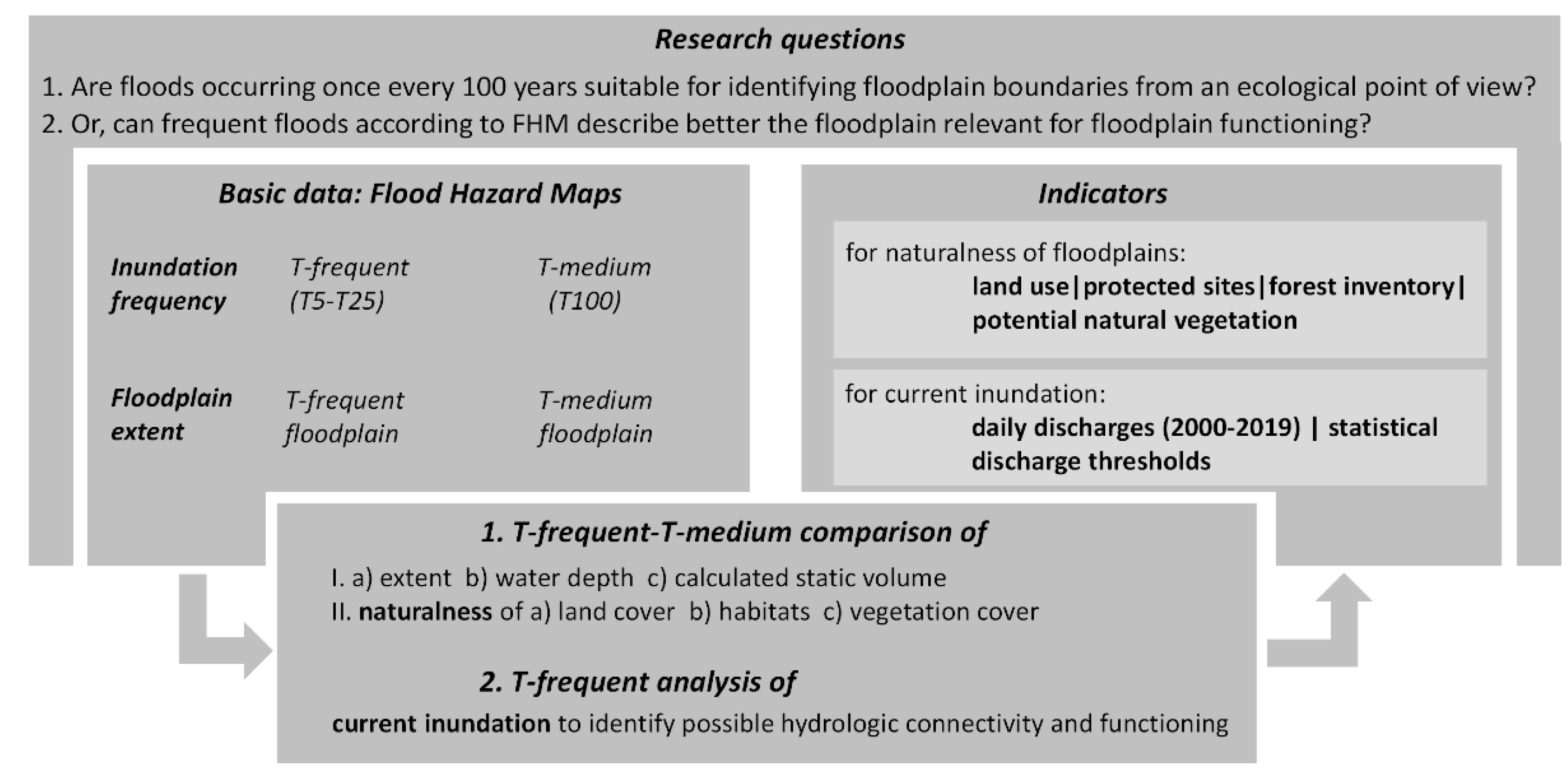
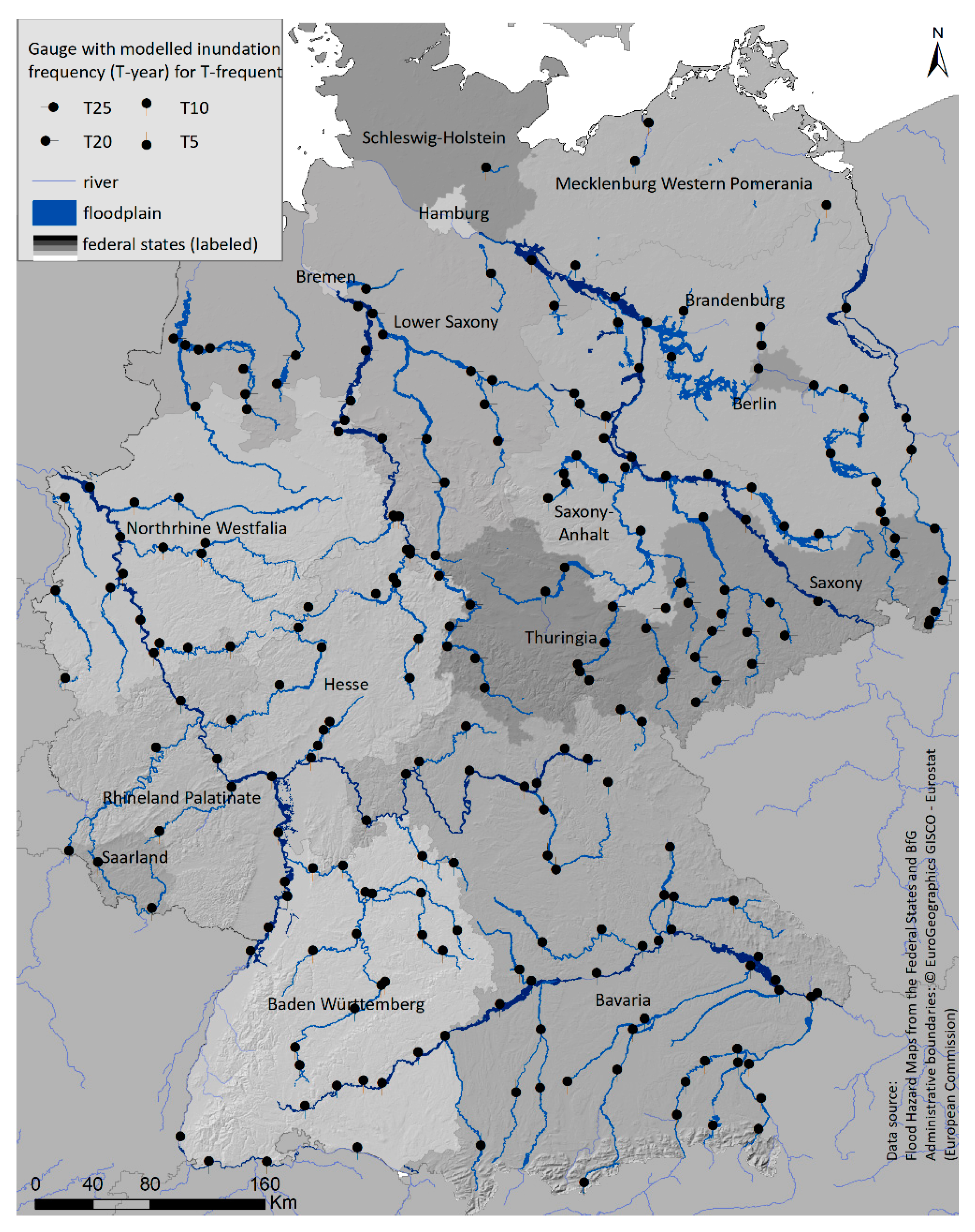
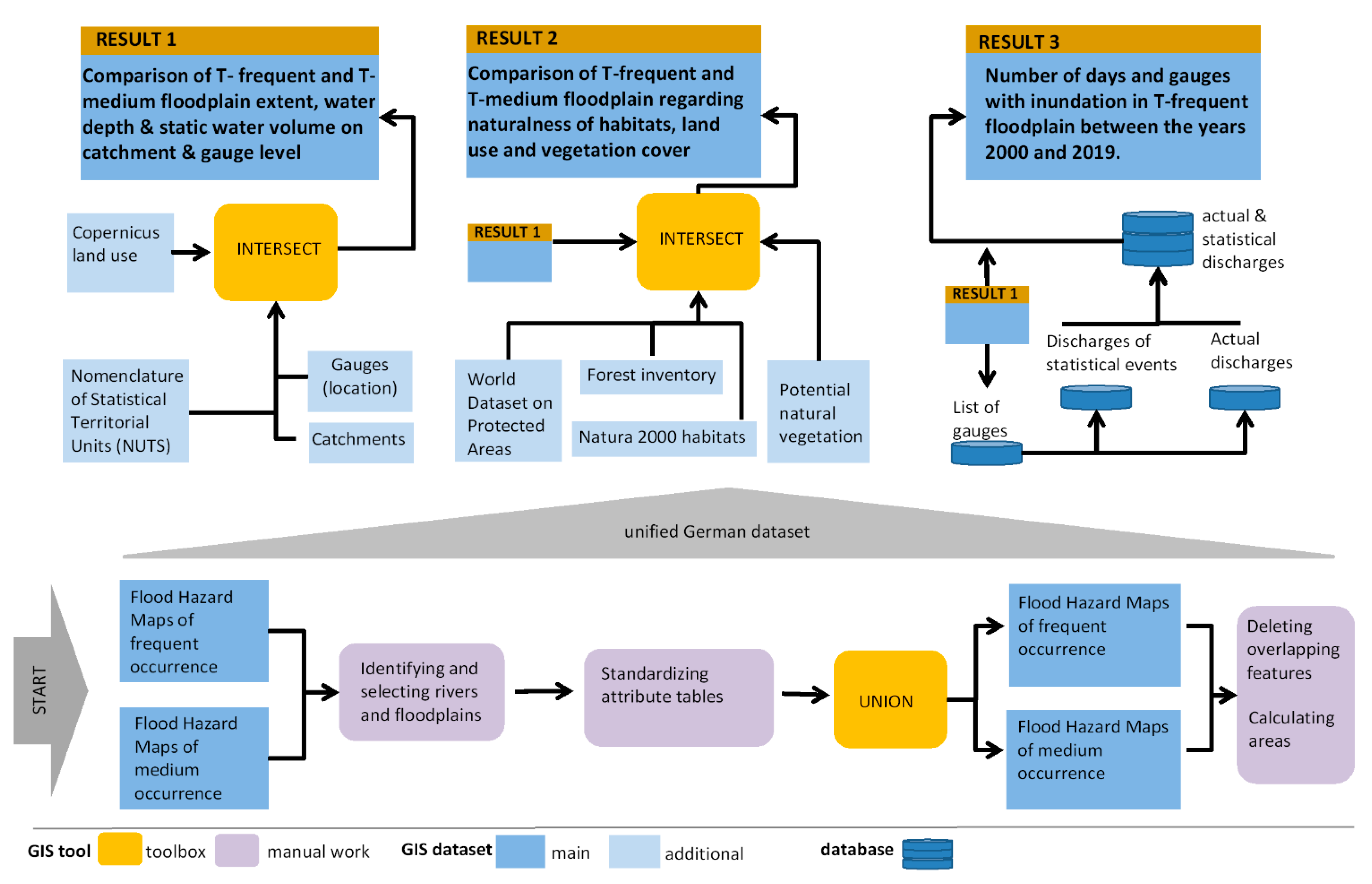
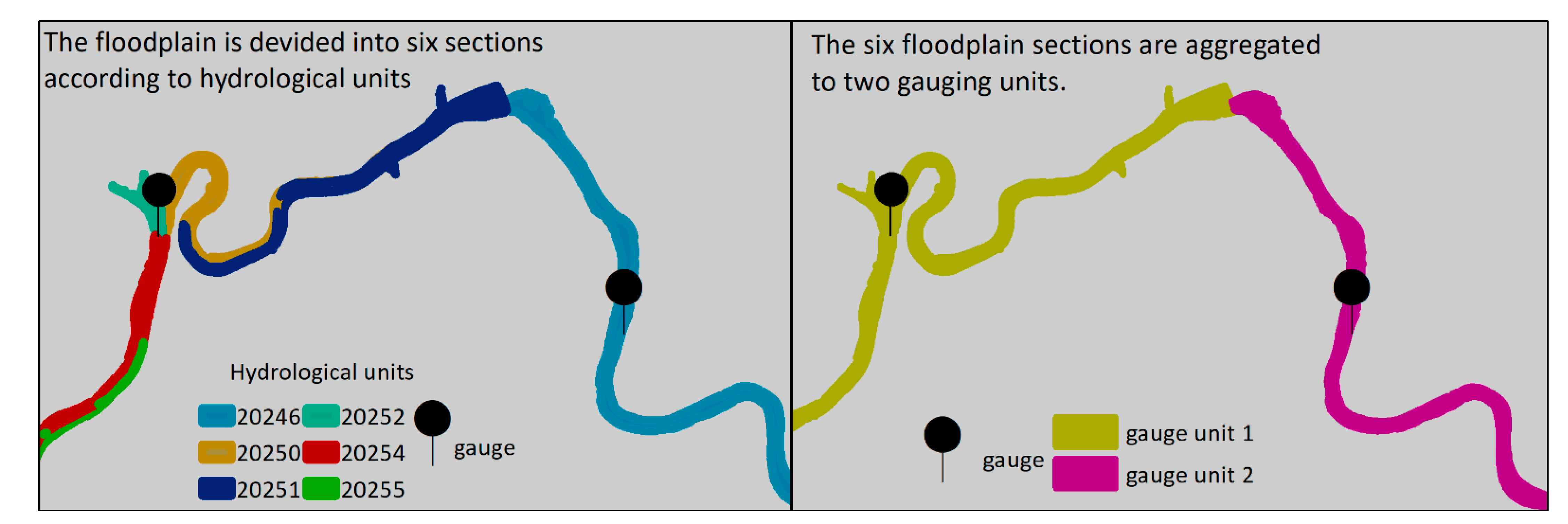
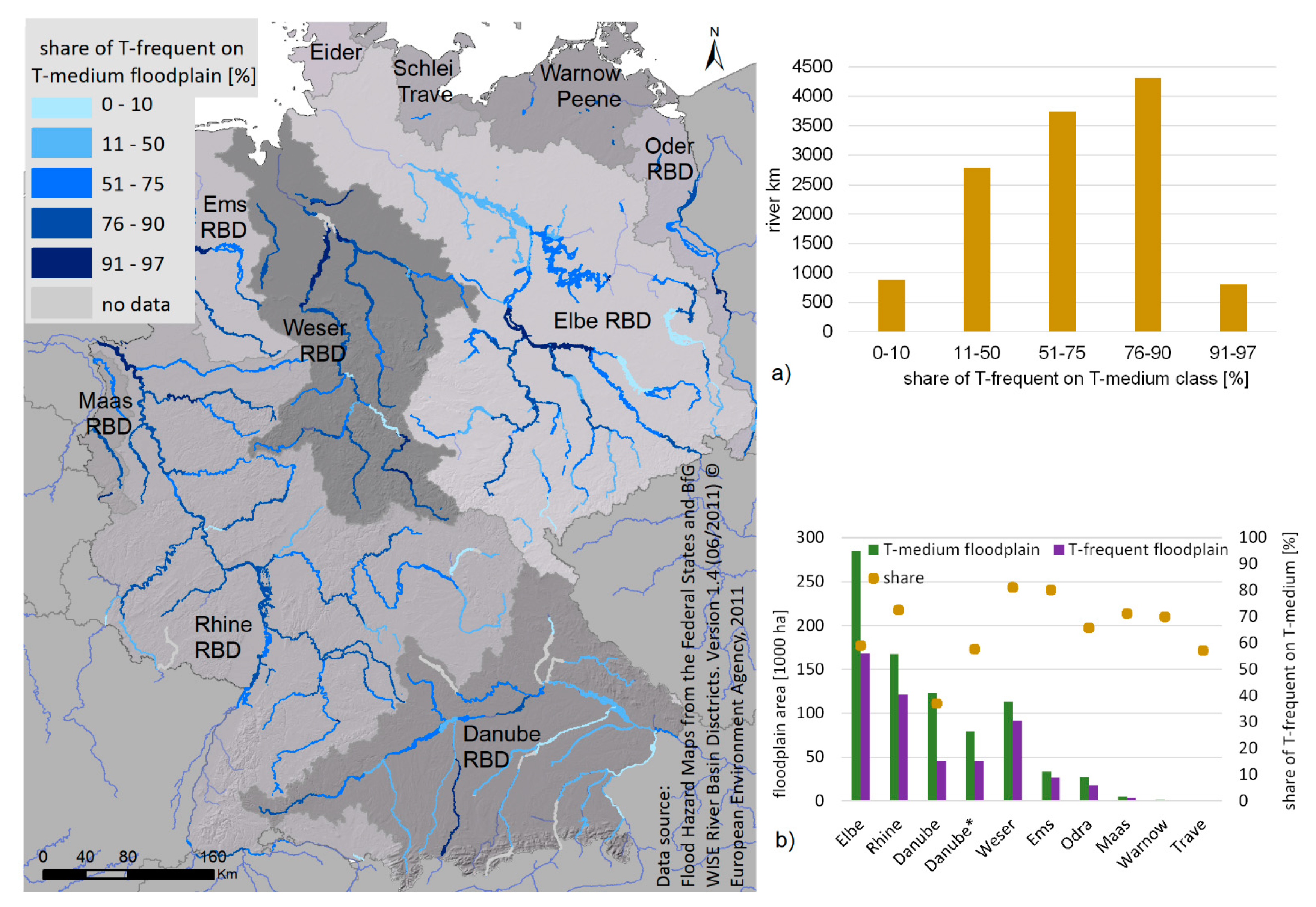
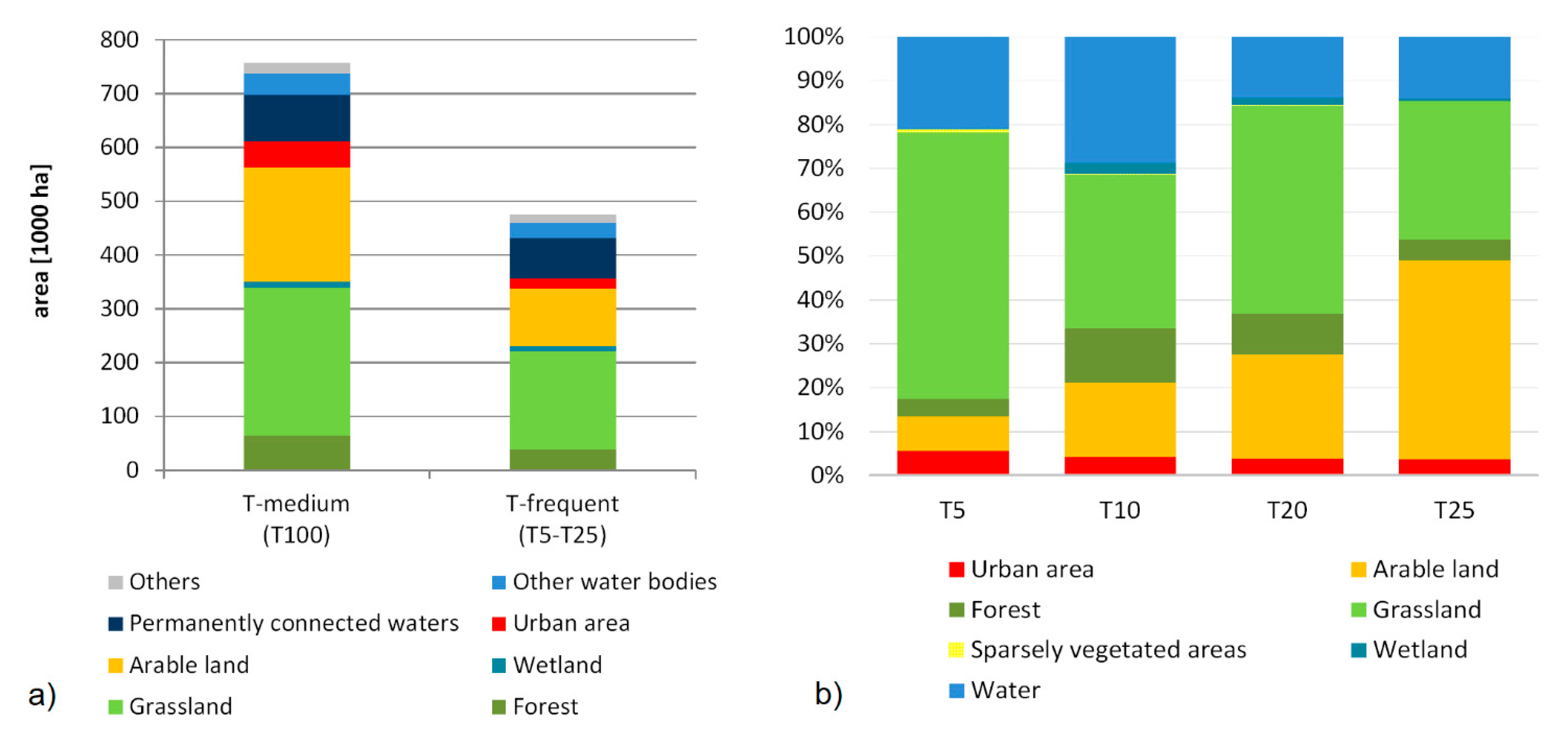
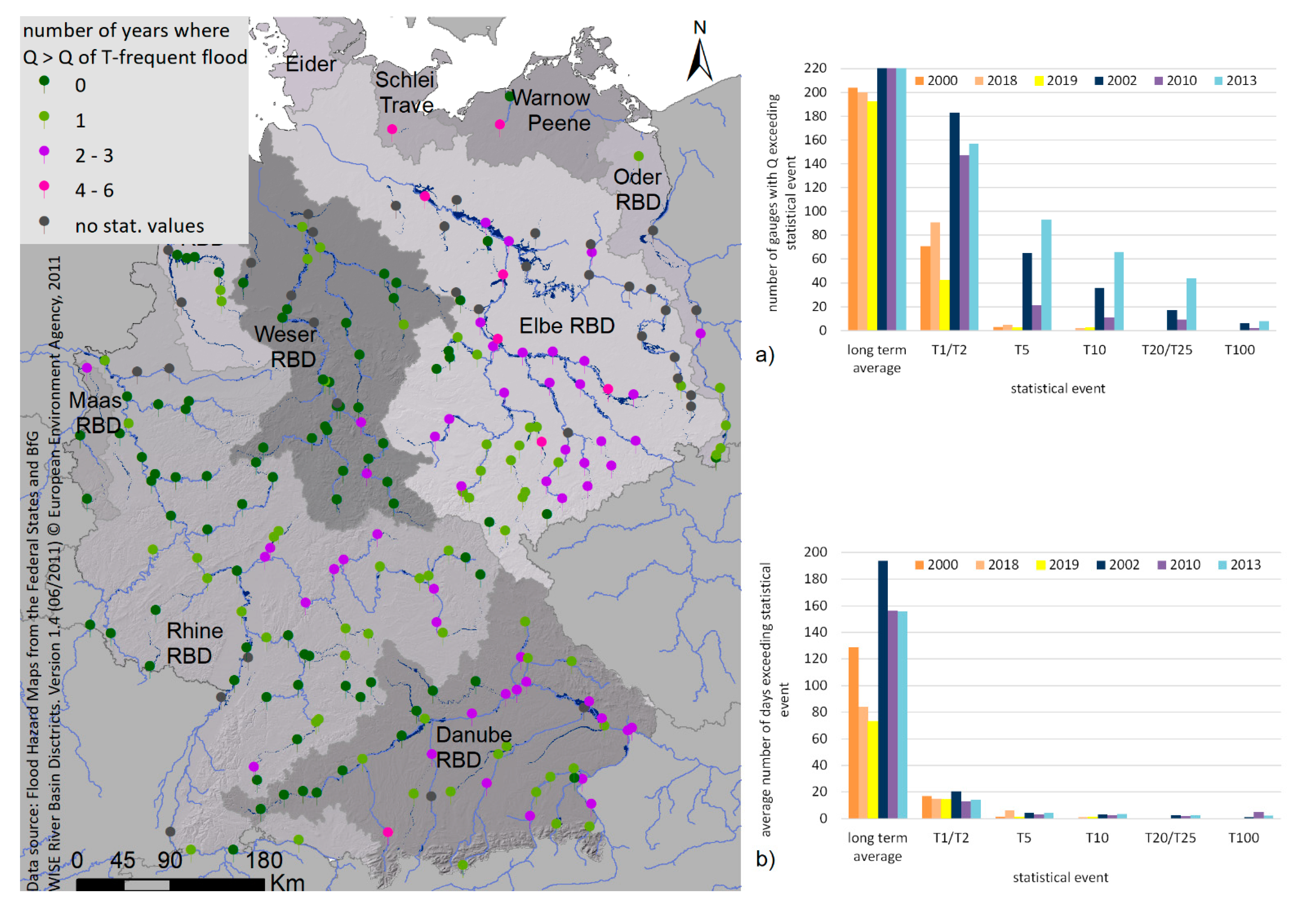
| Applied Nomenclature in This Study | German | English | ||
|---|---|---|---|---|
| Inundation Frequency According to FHM | T-Year Recurrence Interval | Statistic Main Values as HQT | T-Year Recurrence Interval | Annual Exceedance Probability |
| HQ1 | 1 | 1 | ||
| HQ2 | 2 | 0.5 | ||
| T-frequent | T-5 | HQ5 | 5 | 0.2 |
| T-10 | HQ10 | 10 | 0.1 | |
| T-20 | HQ20 | 20 | 0.05 | |
| T-25 | HQ25 | 25 | 0.04 | |
| T-50 | HQ50 | 50 | 0.02 | |
| T-medium | T-100 | HQ100 | 100 | 0.001 |
| FS | Recurrence Interval of T-Frequent and T-Medium Floods | Data Source | Area along Selected Rivers (1000 ha) | Number of Rivers |
|---|---|---|---|---|
| FHM | ||||
| Brandenburg | T10/T20 | FS | 62.7/5 | 8 |
| T100 | FS | 129.6 | 8 | |
| Baden Württemberg | T10 | FS | 27.2 | 9 |
| T100 | FS | 36.7 | 9 | |
| Bavaria | T5/T10/T20 | FS | 3.2/55.3 | 21 * |
| T100 | FS | 146.5 | 23 | |
| Bremen | T20/T25 | FS | 0 | 2 |
| T100 | BfG | 0.6 | 2 | |
| Hesse | T10/T20/T25 | FS | 25.3/0.8/0.9 | 10 |
| T100 | BfG | 40.2 | 10 | |
| Mecklenburg Western Pomerania | T10/T20 | FS | 2.8 | 5 |
| T100 | FS | 5.4 | 5 | |
| Lower Saxony | T10/T20/T25 | FS | 50.3/45 | 14 |
| T100 | FS | 126.7 | 14 | |
| North Rhine Westphalia | T10/T20/T25 | FS | 37.6/13.8/8.3 | 14 |
| T100 | FS | 72.9 | 15 | |
| Rhineland Palatinate | T10 | FS | 23.9 | 6 |
| T100 | FS | 30.1 | 6 | |
| Saarland | T100 | FS | 4.5 | 4 |
| Saxony | T10/T20/T25 | FS | 19.3/8.2 | 10 |
| T100 | FS | 46.5 | 10 | |
| Saxony Anhalt | T10/T20/T25 | FS | 28.9/42.3 | 11 |
| T100 | FS | 94.3 | 12 | |
| Schleswig-Holstein | T10/T20 | FS | 0 | 2 * |
| T100 | FS | 0.9 | 3 | |
| Thuringia | T10/T20 | FS | 14.5 | 6 |
| T100 | FS | 21.5 | 6 |
| Dataset | URL |
|---|---|
| Copernicus Land Use Dataset for Riparian Zones | http://land.copernicus.eu/local/riparian-zones/land-cover-land-use-lclu-image/view |
| GIS World Dataset of Protected Areas (WDPA) | https://www.protectedplanet.net/country/DE |
| Natura 2000 database and GIS data (Prod-ID: DAT-68-en) | https://www.eea.europa.eu/data-and-maps/data/natura-11 |
| Protection Sites in T-Frequent | Protection Sites in T-Medium | |||||
|---|---|---|---|---|---|---|
| Area [ha] | % | Number | Area [ha] | % | Number | |
| Landscape Protection Area (LPA) | 266,272.5 | 55.9 | 896 | 389,903.9 | 51.5 | 1113 |
| National Park (NP) | 5618.2 | 1.2 | 2 | 6055.5 | 0.8 | 2 |
| Nature Reserve (NR) | 101,227.7 | 21.2 | 755 | 126,557.6 | 16.7 | 900 |
| Ramsar Site | 19,267.2 | 4.0 | 11 | 25,050.2 | 3.3 | 11 |
| Site of Community Importance (SCI) | 215,918.5 | 45.3 | 572 | 283,845.7 | 28.5 | 692 |
| Special Protection Area (SPA) | 188,576.5 | 39.6 | 169 | 279,247.6 | 36.9 | 207 |
| 2018 Level 4 Code | Old Level 4 Description | Applied Level 4 Code | Applied Level 4 Description | Area [ha] T-Frequent | Area [ha] T-Medium | ||
|---|---|---|---|---|---|---|---|
| 3.0.0.0 | UA Forest | 3.0.0.0 | UA Forest | 5974 | 6941 | ||
| 3.1.1.0 | Natural & Semi-Natural Broadleaved Forest | 3.1.1.0 | Natural & Semi-Natural Broadleaved Forest | 7325 | 30,474 | 14,051 | 43,123 |
| 3.1.1.1 | Riparian & Fluvial Broadleaved Forest (T.C.D. > 80%) | 23,150 | 29,072 | ||||
| 3.1.2.0 | Highly Artificial Broadleaved Plantations | 3.1.2.0 | Highly Artificial Broadleaved Plantations | 2 | 3 | ||
| 3.1.2.1 | Riparian & Fluvial Broadleaved Forest (T.C.D. > 50–80%) | 3.1.1.0 | Natural & Semi-Natural Broadleaved Forest | 10 | 6200 | 92 | 8585 |
| 3.1.3.1 | Riparian & Fluvial Broadleaved Forest (T.C.D. > 30–50%) | 6190 | 8492 | ||||
| 3.2.1.0 | Natural & Semi-Natural Coniferous Forest | 3.2.1.0 | Natural & Semi-Natural Coniferous Forest | 82 | 2501 | 298 | 5839 |
| 3.2.1.1 | Riparian & Fluvial Coniferous Forest (T.C.D. > 80%) | 1381 | 3381 | ||||
| 3.2.2.1 | Riparian & Fluvial Coniferous Forest (T.C.D. > 50–80%) | 0 | 6 | ||||
| 3.2.3.1 | Riparian & Fluvial Coniferous Forest (T.C.D. > 30–50%) | 1037 | 2154 | ||||
| 3.3.1.0 | Natural & Semi-Natural Mixed Forest | 3.3.1.0 | Natural & Semi-Natural Mixed Forest | 411 | 3553 | 682 | 6621 |
| 3.3.1.1 | Riparian & Fluvial Mixed Forest (T.C.D. > 80%) | 1971 | 4337 | ||||
| 3.3.2.1 | Riparian & Fluvial Mixed Forest (T.C.D. > 50–80%) | 0 | 1 | ||||
| 3.3.3.1 | Riparian & Fluvial Mixed Forest (T.C.D. > 30–50%) | 1171 | 1601 | ||||
| 3.4.1.0 | Transitional Woodland & Scrub | 3.4.1.0 | Transitional Woodland & Scrub | 943 | 4106 | 1733 | 6068 |
| 3.4.1.1 | Transitional Woodland & Scrub | 3163 | 4335 | ||||
| 3.4.1.2 | Lines of Trees & Scrub | 3.4.2.0 | Lines of Trees & Scrub | 486 | 650 | 735 | 987 |
| 3.4.2.0 | Lines of Trees & Scrub | 164 | 252 | ||||
Publisher’s Note: MDPI stays neutral with regard to jurisdictional claims in published maps and institutional affiliations. |
© 2021 by the author. Licensee MDPI, Basel, Switzerland. This article is an open access article distributed under the terms and conditions of the Creative Commons Attribution (CC BY) license (http://creativecommons.org/licenses/by/4.0/).
Share and Cite
Natho, S. How Flood Hazard Maps Improve the Understanding of Ecologically Active Floodplains. Water 2021, 13, 937. https://doi.org/10.3390/w13070937
Natho S. How Flood Hazard Maps Improve the Understanding of Ecologically Active Floodplains. Water. 2021; 13(7):937. https://doi.org/10.3390/w13070937
Chicago/Turabian StyleNatho, Stephanie. 2021. "How Flood Hazard Maps Improve the Understanding of Ecologically Active Floodplains" Water 13, no. 7: 937. https://doi.org/10.3390/w13070937
APA StyleNatho, S. (2021). How Flood Hazard Maps Improve the Understanding of Ecologically Active Floodplains. Water, 13(7), 937. https://doi.org/10.3390/w13070937





